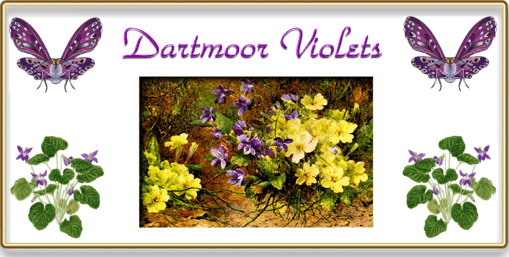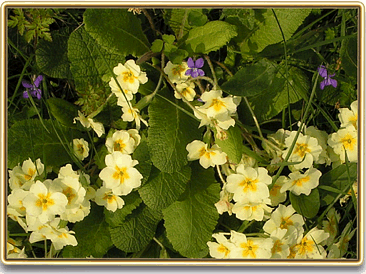
Springtime on Dartmoor sees the emergence of the delicate violet, often nestled under a hedgebank alongside the primrose. This sweet scented harbinger of warmer days has for centuries been part of the moorman’s medicine cabinet and lore. The violet is common along the hedgebanks and row of the lower moorland fringes and is often found phalanxed by the more ebullient primrose.
There are in fact two main species of violet found on Dartmoors, the sweet violet and the later flowering less scented Dog Violet, both are classed as a herb. Since medieval times the violet has represented the month of March in the flower calendar because this was the normal month of its emergence. However this year (2007) some violets were seen flowering in February so perhaps with global warming there could be a conflict with the primrose. . As a flower the violet represents modesty, hence the phrase: “a shrinking violet” It also denoted faithfulness as described in this slushy piece of verse, “Violet is for faithfulness, Which in me shall abide, Hoping likewise that from your heart You will not let it hide.” In the early 1800s was adopted by the Bonapartists as their symbol and Napoleon became known as “Caporal Violet, the little flower that returns with spring”. The sweet violet is regarded as the true flower of Valentine’s Day as legend has it that whilst in prison, St Valentine wrote a letter to his lover with ink made from violets.
In medieval times the violet was thought to provide protection from all things of an evil nature and was often strewn around the house. In the late 1700s it was supposed that if ever you dreamt of violets it would mean that your life was about to take a major turn for the better. It was also believed that if ever violets bloomed in autumn it was the precursor to a major epidemic or disaster the following year. Many years ago there would have been a great uproar if a child brought into the house anything less than a handful of violets as this was deemed very unlucky. Similarly when taking violets in the farmhouses where poultry was reared it was essential that there were more than 13, anything less would result in the young birds dying. One old woman in the Chagford area once related how her mother always festooned the cottage with violets at Easter to ensure good luck for the rest of the year. Akin to finding a four-leafed clover was to come across a clump of white violets, if picked, pressed and dried the flower would invite good fortune for as long as it was kept. I can remember finding my first white violet and doing exactly that until moving up to Chagford where many of the small lanes are carpeted with white violets. It became an everyday sight and tended to detract from the supposed rarity of the plant and its lucky tradition.

Dartmoor Hedgerow Violets
But it was for medicinal use that the violet was best known providing a whole plethora of cures for many illnesses. Poultices of violets were used to ease swelling and relieve ulcers whilst a drink made from the flowers would be taken to cure a sore throat. Concoctions made from the leaves of the violet were often used to ease the symptoms of catarrh and bronchitis. They are also said to help lessen any rheumatic pains. One such recipe was to take a handful of leaves and put them in a pint of boiling water. This should then be left to stand for about 12 hours and a compress made, having done so it should be applied to the affected area and let bide until dry.
The other well know use of violets is in perfumes and toiletries due to the delicate scent of the flower. A company called Lownds Pateman based in Torquay are said to have been the first producers of Devon Violet scent which to this day is still available and dare I say it is a great hit with the older generation. To this day I can still remember one aunt who along with her house always smelt of violets. She also was very fond of those small violet sweets that came in a tin and never went anywhere without a supply rattling in her handbag. The older Devon Violet scent bottles can today fetch around £8 on such sites as eBay such is their popularity.
The other use of the violet is in food, today it will occasionally appear in a sophisticated salad at some restaurant along with an extortionate price tag. Although not a staple part of the old moorland diet a few adventurous cooks had been known to use it, mainly in cordials, preserves and teas. One such recipe for tea is as follows:
1 cup boiling water
1 tsp. dried violet leaves
1 tsp. dried violet petals
Place the leaves and petals on a baking tray in a preheated oven at 150ºc, leave there until all the natural moisture has gone. Then place in a sealable bag until required.
Fill a mug with boiling water and add a generous quantity of dried flowers and leaves, leave to stew for 10 minutes and sweeten with honey.
Please remember that under the 1981 Wildlife and Countryside Act if any person not being: “an authorised person intentionally uproots any wild plant not included in schedule 8, he shall be guilty of an offence”. Which basically means that as the wild violet is not listed in schedule 8 as a protected species anybody picking such must obtain the landowners permission. Although the act does state, “he shall be guilty of an offence”, does this mean that all females are exempt? So best not go binning your Typhoo with the intention of replacing it with free, hedgerow, violet tea, unless you are a female.
 Legendary Dartmoor The many aspects past and present of Dartmoor
Legendary Dartmoor The many aspects past and present of Dartmoor
